Southwest Myofunctional Therapy offers relief to sufferers of orofacial myofunctional disorders
Orofacial myofunctional disorders, or OMDs, are muscle disorders that affect the mouth, jaw, lips, or face. Millions of Americans, both adults and children, suffer from OMDs. Fortunately, medicine has made great strides in orofacial myofunctional therapy for treatment of OMDs, and there are a variety of options for those who suffer from these conditions.
What are orofacial myofunctional disorders?
Generally speaking, OMDs involve the misalignment and improper use patterns of the muscles of the jaw and face. To better understand OMDs, let’s take a look at some of their types:
Tongue thrust
Tongue thrust is one of the most common OMDs. In a patient with tongue thrust, the tongue sits either farther forward or farther to the side than normal, protruding through the teeth. The tongue may stick out during speaking, swallowing, when at rest, or all three. You may have noticed that infants exhibit tongue thrusting behavior. All babies use a swallowing pattern involving a forward tongue thrust early in life, but the majority grow out of the behavior around six months of age.
The average person swallows around 1000 times per day. Each time we swallow, the muscles of our tongue, throat and jaw have to work together. In order for this to work, the tongue has to push. Normally, it pushes against the roof of the mouth, which easily absorbs the force. However, for people with tongue thrust, each one of these swallows is accompanied by their tongue pushing forward or sideways against their teeth rather than up against the roof of their mouth. Over time, this pressure pushes the teeth out of alignment, leading to an open bite or malocclusion. This problem is particularly pronounced in children who suffer from tongue thrust, since their mouths are still developing, but it affects adults as well.
Check back soon for Welcome to the Southwest Myofunctional Therapy blog, part 2! In the meantime, check out our page on orofacial myofunctional therapy.
Office Hours
MON - THU8:30 am - 5:00 pm
FRI - SUNBy appointments only






